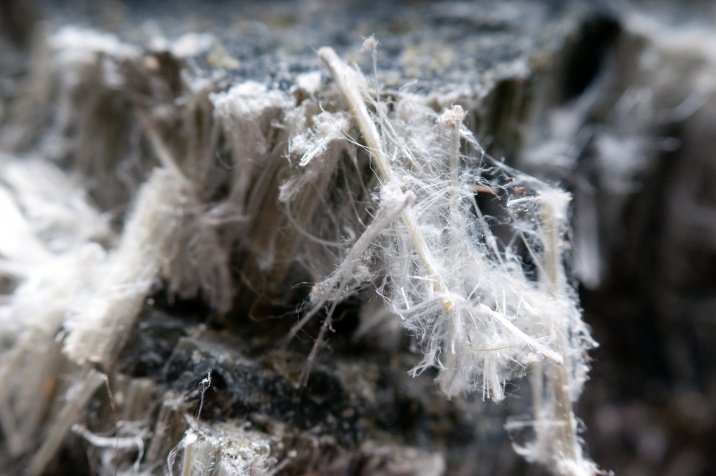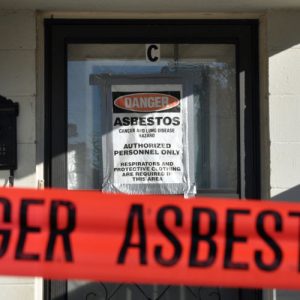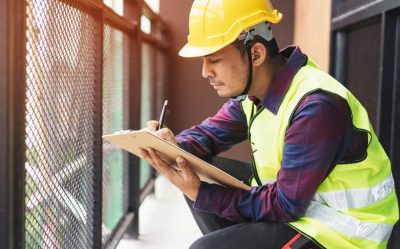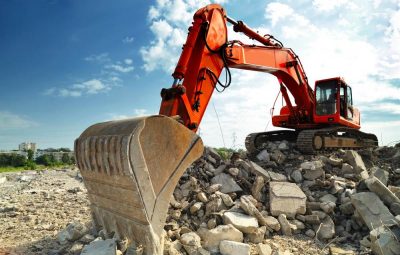- Oneflare /
- Cost Guides /
- Asbestos

How much does Asbestos Removal cost in 2023?
$40 - $120 per m2
What's on this page
- How Much Does Asbestos Removal Cost?
- Asbestos Removal Per Square Metre?
- Asbestos Inspection Cost?
- The History of Asbestos in Australia
- Forms of Asbestos
- Where was Asbestos Used?
- Factors the Cost of Asbestos Removal
- Different Types of Asbestos Removal
- Does the Cost Differ Based on Location?
- How to Create an Accurate Estimate
- How to Hire an Asbestos Removalist
- How to Save on an Asbestos Removalist
Read Related Asbestos Removal Articles
How Much Does Asbestos Removal Cost?
The average cost for asbestos removal is $1,300 to $4,000, with soil clean-up estimated at $190 per tonne. If an entire roof needs to be removed, this can run as high as $5,500 before roof replacement.
How Much Does Asbestos Removal Cost Per Square Metre?
Asbestos removal costs can be estimated at $100 per square metre for flooring, ceiling or cladding. The starting rates for removals begin at approximately $40 per square metre. Be aware that prices can run as high as $110. If the asbestos containment contractor can use encapsulation rather than removal, costs may drop to $12 per square metre.
| Approximate size | Averaged Reported Cost |
| 0m² – 20m² | $250 – $850 |
| 21m² – 40m² | $800 – $1,500 |
| 41m² – 60m² | $1,500 – $2,040 |
| 61m² – 80m² | $2,100 – $4,000 |
| 81m² – 100m² | $6,000 – $9,500 |
| 100m² | +$9,500+ |
How Much Does an Asbestos Inspection Cost?
You should budget $400 for a thorough asbestos inspection. You may also have to absorb asbestos testing costs for multiple samples. You can keep lab costs down by merely refusing same day service and agreeing to a five-day or week-long wait.
The History and Dangers of Asbestos in Australia
Asbestos was finally banned in 2003, with almost every home built before that time having a high chance of containing asbestos. The most likely households to have asbestos were built before 1990, which was when asbestos could be used in the interior and exterior of your home.
History
As early as 1911, authorities were aware that asbestos miners were getting sick. Ventilation was suggested, but nothing else had been addressed. In the 1960s, the illnesses among construction workers were known within the building trades community. Still, the issue didn’t get addressed until the building unions demanded action in the 1970s. Much asbestos was phased out by 1990 because the public finally began to see how it was causing cancer among average Australians. Still, some use continued until the full ban in 2003.
It’s not a surprise that asbestos was widely used. It was inexpensive, versatile, and useful and allowed for building supplies could be made more cheaply. Asbestos worked behind the scenes as subfloors, fibreboard, insulation, sealants, and wall cladding. It was useful on the exterior, providing durable eaves, roofs and gutters. Unfortunately, the material is dangerous to anyone who comes into contact with it.
Dangers and Effect on Health
Asbestos doesn’t stay where it’s put. The material easily releases into the air, entering human lungs. Over time this causes respiratory problems and leads to lung cancer and mesothelioma.
Diseases
Perhaps if asbestos made someone sick immediately, the Australian government would have outlawed it sooner. A slow killer, illnesses are related to the person’s age at exposure, the frequency of exposure in terms of the number of times and the length of time, as well as which type of asbestos.
Mesothelioma and Lung Cancer
Every year, about 675 deaths are attributed to mesothelioma and lung cancer caused by asbestos. These problems may have developed over time due to exposure to friable asbestos. However, just as many are attributable to people who did their own home renovations, unaware of the danger of disturbing bonded asbestos.
Forms of Asbestos
Whether it’s bonded or friable, asbestos is an illness waiting to happen.
Bonded/Non-friable asbestos: Bonded asbestos is commonly used in exterior or interior cladding, which can be punctured by accident or deliberately drilled in renovations. Every opening allows the material to escape, and the problem compounds over time.
Friable: This is loose asbestos that was sprayed on in the factory or directly onto surfaces in the home. Tiny cancer-causing asbestos fibres are released when it is installed, and that release continues over time.
Where was Asbestos Used?
Inside the house, bonded and friable asbestos can be found in ceilings, walls and floors, while you can find asbestos externally in:
| Interior | Exterior |
| Fibreboard | Corrugated asbestos roof sheeting |
| Insulation | Guttering |
| Floor backing | Fencing |
| Carpet underlay | Eaves |
| Plaster sealants | Fascias |
| Gables | |
| Brick sealants |
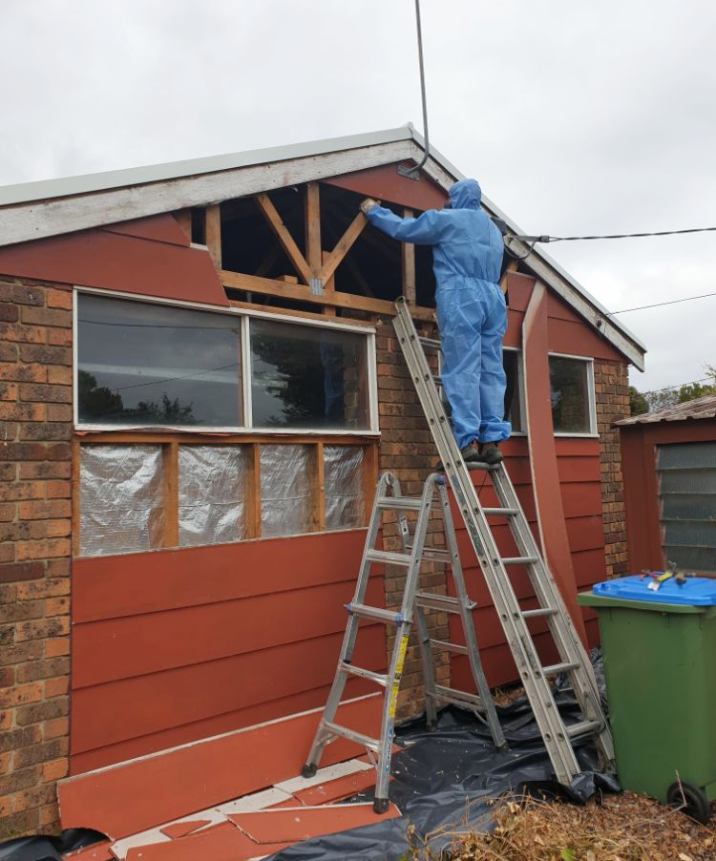
Asbestos removal professional carefully removing asbestos from a building. | Source: Aussie Asbestos Solutions P/L
Factors Impacting the Cost of Asbestos Removal
The main factors that will affect your costs include amount, location, condition, related materials and accessibility.
Condition of asbestos: If asbestos is already damaged, it is more difficult and more dangerous to remove and, therefore, more costly in terms of preparation and labour.
Amount of asbestos: The area covered by the asbestos and the amount of asbestos will affect the price.
Location: Removalists must prepare differently for loose dust, fibres, and large chunks indoors than they do for external items such as roof tiles and fascias.
Access: If asbestos is hard to reach, this will take more preparation, more time, and more abatement clean-up.
Materials: The cost of materials needed to remove asbestos, such as protective gear and asbestos removal bags, can quickly add up. Asbestos bags from Bunnings, which are specifically designed for asbestos disposal, are a key material required for the safe disposal of asbestos-containing materials.
You can also use asbestos disposal bags from Bunnings, which are made with heavy-duty polyethylene to ensure safe handling, transportation and disposal of asbestos. Asbestos removal bags are essential for this removal project; these are also available from Bunnings.
Other expenses: If you are in a remote area, you may need to factor in travel expenses for a certified removalist to come to you. This includes the costs of transporting their equipment to your location and taking the hazardous waste to a distant location.
Price Estimates for Different Types of Asbestos Removal
When you are asking about abatement prices, keep in mind that these do not include replacement costs. Abatement must take precedence over renovations to ensure your family’s safety.
The following costs are by square metre unless otherwise indicated:
| Asbestos Service | Averaged Reported Cost |
| Internal cladding | $70 – $100 |
| Vinyl flooring | $100 |
| Ceiling | $40 – $100 |
| Eaves | $1,500 – $2,500 (total) |
| Roof | $3,500 – $5,000 (total) |
| External cladding | $4,000 – $5,000 (total) |
| Fencing | $25 – $50 (per sheet) |
Does the Cost Differ Based on Location?
The cost of asbestos removal is heavily influenced by the size, amount and accessibility to the areas of your home or building that needs asbestos removal. Therefore, the price can vary drastically from one customer to the next. Oneflare customers in Australia have been quoted the following for asbestos removal:
| State/Territory | Averaged Reported Cost |
| New South Wales | $250 – $2,500 |
| Queensland | $300 – $9,500 |
| South Australia | $250 |
| Victoria | $350 – $800 |
| Western Australia | $250 – $2,500 |
You can expect to pay less in Victoria and Queensland and more in Western Australia. The highest fees were reported in Southern Australia. Here are some examples of average costs of asbestos removal per square metre in Australia cities:
| City | Average Reported Cost (per m²) |
| Melbourne | $25 |
| Gold Coast/Brisbane | $30 |
| Canberra | $30 |
| Darwin | $30 |
| Hobart | $30 |
| Sydney | $35 |
| Perth | $50 |
| Adelaide | $75 |
Tips on How to Create an Accurate Estimate
Tip #1: You should read about asbestos abatement to get an idea of the steps involved in your project. When budgeting, you’ll need to think beyond the asbestos removal price. You’ll want to include inspection, abatement, removal and hauling costs. Despite asbestos roofing removal costs or other reductions, you’ll also have to factor in what the cost of replacement or renovation will be.
Tip #2: Abatement costs are affected by preparation. Thus, it’s cheaper to do everything at once rather than separately. A small job priced at $80 per square metre may drop to $60 for a medium job or $80 for a larger job.
Tip #3: The size of the job, the location of the asbestos may play into the final cost. An asbestos fence removal cost is cheaper because it’s outdoors and stands apart from other structures. On the other hand, a steep or high roof may cost more than a flat one. Asbestos buried behind walls may require tearing out good materials to get to the bad ones.
Tip #4: The best way to create a budget is to get multiple quotes from trustworthy contractors in your area.
How to Hire an Asbestos Removalist
When hiring, make sure that your asbestos removal company is fully certified. All state licenses should be up-to-date. It is illegal for asbestos to be removed by an unlicensed individual or company. You should find out how long the business has operated and what their safety record is.
The company should also be covered by insurance, and you should find out what happens if something goes wrong during the removal. You can also ask about staff training in asbestos removal. After the extraction, the company should be responsible for transporting the asbestos to a proper disposal site.
Finally, ask for references and take some time to call those customers. You can learn from others who have gone through the process. You may want to ask insurance agents or real estate specialists who they trust.
Tips on How to Save Money when hiring an Asbestos Removalist
Tip #1: Encapsulation can be a short-term solution. The inspector is the only person who can decide if this approach is right for your asbestos problem.
Tip #2: Although removal is expensive, your health is your first priority. Also, if you decide to sell the house, asbestos might be discovered, and result in you paying for the removal anyway.
Tip #3: DIY asbestos removal is not only dangerous but illegal and must be completed by professional removalists. Getting quotes is your best bet to keeping your costs down.
* The cost data is based on Oneflare and third-party sources
Real Oneflare Customer Quotes
Tim's Asbestos Job
Job Type
Full house asbestos removal
Removal areas
Ceilings and walls from 2 storeys
Size of areas
Approximately 500m²
$9500inc. gst
Quoted by Angry Ant Asbestos
John's Asbestos Job
Job Type
House removal
Removal Area
Laundry
Removal size
Approximately 12m²
$800inc. gst
Quoted by Mission Demolition
Anthony's Asbestos Job
Job Type
Unbroken asbestos sheet removal
Removal area
Old-style shed
Purpose of removal
Rebuild garage
$50inc. gst
Quoted by Halls Asbestos Removal
